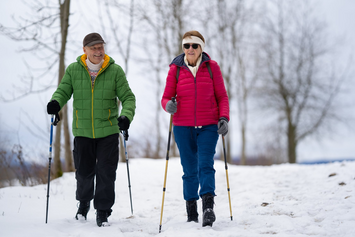Winter Exercise: Stay Warm and Safe
Don't let cold weather keep you inside
 Winter's chilly temperatures can discourage even the most active people from exercising. Especially as we try to avoid cold, flu, and COVID-19 viruses. Don't let viruses and cold weather stop your fitness routine. Staying active, no matter the season, can help you improve or maintain your weight, health, and energy levels.
Winter's chilly temperatures can discourage even the most active people from exercising. Especially as we try to avoid cold, flu, and COVID-19 viruses. Don't let viruses and cold weather stop your fitness routine. Staying active, no matter the season, can help you improve or maintain your weight, health, and energy levels.
You may hesitate to exercise in cold weather when flu and COVID-19 are spreading. But it’s generally safe if you take precautions. Wearing a mask and social distancing can help protect you indoors. If you exercise outside, pay attention to specific cold-weather hazards.
The effect cold weather can have
Breathing in cold and dry air can restrict your airway. This can make breathing more difficult and result in shortness of breath, coughing, wheezing, a tight chest, and an increased risk of a heart attack. Wearing a scarf or mask can warm the air before it enters your lungs, and help you breathe easier. However, if you have asthma or heart problems, you should ask your doctor about any precautions you need based on your health or your medications.
Stay warm and safe
Since the other two risks of exercising in the cold are frostbite and hypothermia, try these tips to stay fit, motivated, and warm:
Mind your head, hands, and feet: You lose heat through your head, so be sure to wear a hat. Insulate your feet with warm thermal socks. Choose mittens over gloves since your fingers will warm each other. You can wear thin gloves under heavier mittens so you can remove a layer if needed.
Watch your step and prevent falls: Avoid slips and falls on snow or ice by wearing sturdy shoes with good traction.
Stay hydrated: Be sure to drink water before, during, and after your workout, even if you don't feel very thirsty. Dehydration can be more difficult to notice during cold-weather exercise. If your lips are chapped, this means you need more water.
Don't overdo it: Both cold weather and exercise put stress on your body, so start your exercise routine slowly and listen to your body.
Dress in layers: Start by wearing a lightweight synthetic material, not cotton, to draw the sweat away from your body and dry quickly. Add another layer or two of wool or fleece for insulating warmth. Then top it off with a lightweight, water-repellent, and wind-resistant material.
Enjoy a safe, active winter season
As you brave the cold and the pandemic to improve your health, track your exercises to be sure you're not overdoing it. Veterans with a My HealtheVet account can log their daily physical activities online to share with their health care team. There's no need to take a break from physical activity when the temperature drops, but you should closely monitor how your body feels to help protect against cold-weather hazards.
Please vote in our unscientific poll. All responses are anonymous.
Read More
Cold Weather Safety for Older Adults (National Institute on Aging at NIH)
Tips for Cold Weather Physical Activity (MOVE!) (PDF)
Winter fitness: Safety tips for exercising outdoors (Mayo Clinic)
Updated December 9, 2022

